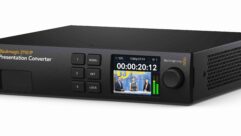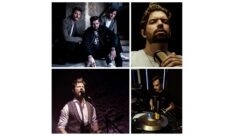SCOPING IT OUT:using the oscilloscope
Jul 1, 1999 12:00 PM,
Glen Ballou
We have all either used or abused oscilloscopes at one time or another.Many times, we did not see what we thought we should have seen, notnecessarily because we did not know what it should have looked like, butbecause the scope did not have the right specs for the job we were doing.Ultimately, what do we need in an oscilloscope? That depends on what we arelooking for. If we are looking at high input level and low frequencies,almost any scope will do. If, however, we are looking at low level RHsignals or high-speed digital signals, we need a scope with highsensitivity, wide frequency response and a fast rise time. If we want tocompare one signal to another, we need a dual beam scope.
Although it is nice to have a scope that can do everything, cost, size andcomplexity of operation probably dictate that we should buy a scope thatonly fits our needs or a little beyond. About 20 years ago, almost anyscope was adequate for an A-Vservice technician. Sound and optical circuitswere low frequency analog. Today, however, we see digital with fast risetimes, VHF and UHF rf microphones and all kinds of TVs, many, like videowalls, linked together through computers. Of course, we cannot forget thatmany sound systems are controlled by computers.
We also need to look at size. Everybody likes a large screen television inhis home, but in a boat or camper where one must carry it around, weusually opt for a small portable unit. That also holds true to scopes. Ifwe are using a scope only on the bench, then a 5 inch or 6 inch (127.5 mmor 152.4 mm) screen is very useful. If we use the scope on the road, asmall, lightweight scope is probably best, such as a Fluke ScopeMeter.Remember that small scopes have small screens, which translates into lowerapparent resolution and more eye strain, but this still may be much betterthan back strain. Another good idea when we are on the road is batterypower. This is especially handy if we are in the bowels of the building,far away from the power outlet, servicing a system in the middle of afield, or in a country with power other than what we are used to. Anotheradvantage of the ScopeMeter type of scope is that it is a digitalmultimeter.
What frequency response do we need? That again depends on the applicationfor which we plan to use the scope. If we are only looking at audio signal,then a scope capable of reproducing from 20 Hz to 20 kHz would be adequate.If, however, we want to see distortion, noise and spikes, we will requireat least a 200 kHz bandwidth. Today’s scopes usually have at least a 5 MHzbandwidth, so frequency response is not usually an issue. If we are lookingat RF, we might require a scope with a bandwidth of 200 MHz or 500 MHz.Frequency response costs money. A 20 MHz scope may cost $600, and a 500 MHzscope can cost more than $10,000.
The scope’s time base is also important. A 20 MHz scope may have a timebase from 0.1 us/div to 0.2 s/div. It is quite common to have fivedivisions on the screen. If we had a 200 MHz signal, which is equivalent to5x10[superscript]-9 seconds per cycle (s/cycle), and we set the time baseto 0.1 us/div (0.1×10[superscript]-6 s/div) we would have 100 cycles (20cycles/div x 5 div) showing on the screen. A 20 Hz signal would have 20cycles on the screen at 0.2 s/div. This is particularly important to knowif we are planning to use the scope to determine frequency.
If we want to look at digital circuits (zeros and ones), we will need ascope that can measure DC. We should also have good rise time because aperfect digital circuit would go from zero to one instantaneously. If wehave a narrow band scope, our signal may look like a sign wave when it isactually a square wave.
Remember that when measuring an AC signal riding on a DC signal, we areseeing both the AC and the DC signal at the same time. The DC signal lookslike an offset with an AC signal riding on it. This can be a potentialproblem. For instance, if we have a 10 mVAC signal riding on a 10 VDCsignal, the AC will hardly be visible. This is the reason scopesincorporate an AC/DC input switch. Look at the DC value at a verticalsensitivity that allows you to see it, then switch to the AC input andincrease the scope input sensitivity to expand the AC signal.
Next, we need to look at vertical sensitivity. Vertical sensitivity isgiven in V/div and often goes from 5 mV/div to 5 V/div in 10 steps. Theinput also has a vernier for adjusting the signal to fit the screen;however, it is only calibrated in the calibrated position. If we want to look at such low-level circuits as micro output, we need a scope with 10 mV sensitivity or better, one mV being much more acceptable. Unfortunately, highsensitivity costs money. If we only need to look at low level signals oncein a while, we might be better off to insert a preamp between the deviceand the scope. Although it will not be calibrated, it will show us thesignal.
Often we like to compare one signal to another. This is where a multi-inputscope can come in handy. We can put one signal on the A channel and thesecond signal on the B channel, and so on. By superimposing the signals, wecan see distortion, phase shift and gain or attenuation between the twosignals.
Scopes have to be triggered to produce a steady trace on the screen. Ifthey are not triggered, the waveform will move either to the left or to theright. There are a variety of ways to trigger a scope. If we are looking ata signal that is related to 60 Hz, we can trigger it off the power line. Ofcourse, if the scope is operating on battery, we will have to trigger itinternally. Normally, a scope is triggered by the signal we are looking at.If it is a sine wave, we can trigger it with either a positive or negativegoing signal. If, however, it is an asymmetrical signal, we will probablywant to trigger it with the polarity, which is larger, often the negativegoing signal. Scopes often have a trigger that will sync to a video signal,whether it be NTSC, PAL, SECAM or HI resolution.
Triggers may be straight forward signal-sensitive triggers, or they may bedelayed, one shot or input sensitive. The straight forward trigger startsthe horizontal sweep at the left side of the screen immediately after thebeam makes a sweep. This looks like a continuous display. All scopes havethis mode.
More sophisticated scopes have delayed and/or one-shot modes. The delayedtrigger starts the sweep a certain length of time before applying thesignal, so the event shows up into the sweep rather than on the leadingedge of the sweep. This is especially helpful when looking at an impulsewave or something that happens at the beginning of a cycle. If we tried tolook at an impulse in regular mode, the beginning of the impulse would becut off.
One-shot sweeps are useful when looking for an intermittent spike orsignal. The scope sits at idle and will only trigger when a signal reachesthe threshold we specify. The scope triggers and then shuts off thehorizontal sweep until we reset the trigger. This way, we can now leave thescope unattended and still see the signal if it occurs.
Most scopes have a 5x mode that expands the horizontal sweep five times.This is useful for expanding the waveform currently under inspection. Wecan also expand or contract the length of the sweep, so a repetitive wavecan be aligned between divisions on the screen. Of course, like thevertical vernier, the sweep is calibrated only in the calibrated mode.
Finally, if we have a dual beam scope, we can trigger one beam with thesignal of the other beam. This can be useful when looking at timerelationships between two events.
One final piece of food for thought. If you usually carry a portable PCwith you on the job, you might want to think of using the the new PC-basedoscilloscope. The Velleman PCS64i is a hardware device that interfaces withthe PC through the parallel port. It is optically connected to the PC toprevent damaging the PC with high voltages and bad grounds. It operateslike a multi-channel digital storage scope. It also includes an FFT todisplay the spectral content of the waveform and has some basic mathfunctions. Bandwidth is DC to16MHz.










